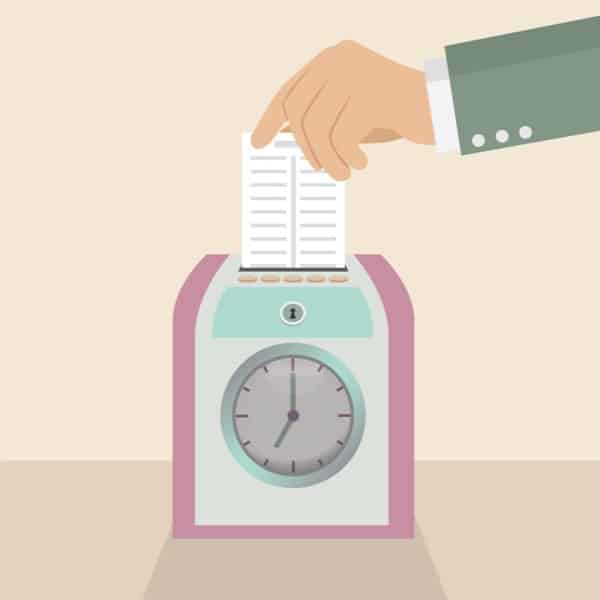
11 Dec How to calculate timecard with an online time clock software.
A time clock enables an employer to track an employee’s clock in and clock out. Unless you know what’s a time card and how does one calculate a time card manually, you might know what I am talking about. And if not, all the information below is going to help you out.
What is an online time clock software?
We will start with an online time clock software. It has a lot of features, such as custom reporting, leave accruals, web clock, mobile app, Slack integration, and pop-up notifications. They are optional and not found on most of the software but are essential when one wants to track an employee’s worked hours efficiently.
An online time clock software uses artificial intelligence and machine learning to calculate your employees’ worked hours while ensuring high accuracy.
Now coming to the second-most important term, the time card.
What is a time card?
Timecard, also known by the term, the timesheet is a convenient method for tracking and recording the number of hours that an employee has spent on the job or at the workplace. A timesheet improved a team’s decision-making capability while enhancing project execution. Companies frequently use it to comply with government and labor regulations.
According to the universal definition, it is a program, such as the online time software or a document to track the number of worked hours in a week, in a day, in a fortnight, in a month, or a year. An online time clock software can also calculate the worked hours of an employee for a particular project.
If you want a record of how much time you have spent working for a week or a month, you can track the number of hours on the timesheet. Back in the days, timecards were completed manually and inserted into a clock for payrolls. But now, you can do it instantly using an online time clock software.
How to calculate a timecard using an online time clock software?
Here are different ways or one can say, features of an online time clock software to calculate timecard:
Browser-based timecard calculation
Online or browser-based time clock software is one of the easiest ways to calculate time cards. An employee can create his account within minutes and can clock in and clock out by simply logging in and logging out of the account.
A reliable time clock software uses artificial intelligence and machine learning, so, all the information is fetched and gathered in real-time. Then, the administrative staff and even the managers can access the information and take a thorough look at the automatically-generated payroll and timecard.
The built-in timecard calculator in the time clock software allows the employees to calculate overtime hours.
Other than that, employees can use the web-based time clock software to see their time card data and even request paid time-off. A centrally-controlled online time clock software will accumulate information in real-time and help you to avoid paper trails so you can access the data within seconds. Instead of spending hours, you can now prepare and get your payroll under 2 to 10 minutes, depending on the software speed.
How does web-based time clock software work?
Follow these steps for calculating timecard using web-based software:
Go online
Generally, you have the freedom to use any browser, unless the software is restricted to be used on a particular browser. You can clock in and clock out from the approved locations. If you are using a web-based time clock software, you can access your timecard using the program’s mobile app or any other browser.
Set necessary restrictions
Your employer will have set the necessary locations. As an employee, you can then, only clock in and clock out using the locations approved by your employer. Restrictions can be set on both, static and dynamic IP addresses.
Calculate the timecard without any convenience
Implementing a time clock software can help your company grow while allowing you to get your payroll within 2 to 10 minutes. Some time clock solutions come with added features that can help you see your timecard in segments.
Slack timecard calculation
Slack-integrated time clock software allows the employees to clock in and clock out from Slack using simple commands. Most of the time clock software has HR chatbots that respond to each employee’s queries. For instance, they can tell the chatbot about the paid-time-off (PTO), clock in and clock out time.
Like web-based time clock software, you can calculate paid time-off, overtime hours, break hours, and worked hours in real-time.
How does it work?
Here are simple steps to figure out how slack-based time clock software works:
Log in to your account
Log in to your time clock software account. If you are new and do not own an account, the software will provide you the link and you can sign up easily.
Slack integration
Slack integration is optional in many time clock software. If you have the option to integrate with Slack, navigate to the account settings on the menu, and go through all the integrations. Select slack integration.
Authorize
Integrating is not as easy as it seems. You will have to authorize by adding the slack integration. After that, multiple windows will open up, asking for permissions.
Grant all the permissions
After authorization and granting permissions, you will also have to select the channel to which the time clock software posts.
Timecard calculations for mobile phones
Mobile-based time clock solutions allow employers to track the locations of the employees using their devices. Employers can easily track the clock in and clock out time and even assign the routes to them. Advanced time clock apps also display the route completion for each employee.
The app then accumulates all the information in real-time and, inputs it into the timecard calculator to generate payroll under 10 minutes.
Kiosk-based timecard calculation
Kiosk time clock programs work just like web time clock solutions. If all of your employees have a tablet, they set it up as a time clock and input the attendance and accurate time using single clock time software.
With the kiosk-based timecard calculator, you can get real-time employee payroll reports in a matter of few clicks.
However, an employer, sometimes, has to put geofences: location restrictions to ensure that the software is only functional within a geographical limit. The necessary protocol avoids unrealistic clock in and clock out by the employees.
If you have introduced a kiosk timecard calculator, all the employees can input the clock in and clock out time using one application. Unlike web-based time clock software, they won’t have to log in to their accounts again and again.
To authenticate the clock in and clock out times, most of the software take the help of pins. It avoids buddy punching and works best for employees having a large number of employees.
Biometric time clock calculation
Biometric time clock software is a digital solution for the employees to clock in and clock out. employees can use an RFID card, a pin, facial recognition, or even their fingerprint to punch their attendance.
When using a biometric time clock solution, fingerprint seems to be a viable option as it avoids buddy punching. The software using biometric technology is pretty robust and has the capability to save data in case the internet is shut off. This is why it’s ideal for many companies out there.
The software reads the data from installed biometric time clocks and allows the employers to run payrolls within 10 minutes. The time card calculator calculates break hours, paid time-off overtime hours, lunch hours, and worked hours.
A typical time clock software syncs data across all the office-granted devices and allows the employees to clock in and clock out conveniently.
Why is a time card calculator a necessity? – more facts about a timecard
Apart from the time card having the clock out and clock in time, it might also contain a detailed and brief breakdown of project tasks accomplished by an individual. Moreover, this information might be accessed by managers and the administrative staff in real-time for calculating project-costing, project management, tracking, job estimation, payroll, and client billing.
Tracking time and maintaining time cards can significantly reduce an organization’s costs by running and generating payrolls efficiently. Some time clock software automated invoicing and billing for added efficiency.
Tracking time can increase an organization’s revenue through automated billing. The process facilitates invoicing by providing full access to accurate data of the worked hours, paid time off hours, and much more by the consultation staff. In return, an inconvenience that employers have to face because of missed bills eliminates and payments are received and given much faster than the traditional method.
Manual timecard calculation Vs. Online time clock solution- How to calculate timecard manually?
Long before the online time clock software was invented, people used to calculate the timecard manually from their time clocks. Calculating worked hours manually can be tricky. Those who do not like math and complex calculations should thank the inventors of timecard calculators.
Calculating worked hours
Calculating timecard manually can be error-prone and a lengthy process. Thus, the reason why people prefer time clock software.
A common method to calculate employee hours is to record start (clock in) and end time (clock out) for the hours worked. Some of the employers still require the workers to record their hours on the papers, whereas, others use time clock software and are free of this hassle. Once the worked hours are recorded, the employees will calculate the total and generate/run a payroll.
Example of how to calculate worked hours
For you to understand the manual method, we will decide on a clock in and clock out time. The goal of this example is to determine the entire duration of work using the start and end times. For instance, an employee who starts at 8 am and ends at 2 pm would result in 6 hours.
Here’s how you can determine worked hours:
- Convert all the start and end times to military time (24-hour clock). For instance, convert 8 am to 8:00 hours and 2 pm to 14:00 hours
- After that, subtract the clock in time from the clock out time
- This way, you will get the actual worked hours and minutes for the day
- To determine your wage, you would need to convert the worked hours and minutes to a decimal format
- Converting hours to a decimal value and calculating gross wage
To determine total wage, you would need to convert total hours and minutes to a decimal format. Once the math is done and you have converted accurately, you can use the formula, (time worked multiplied by wage) to determine gross wage.
For example, if the employee works for 10:30 minutes, it is 10.5 hours when converted into decimal. After that, multiply the number you have gotten to the hourly wage. This calculation will get you a gross wage.
Advantages of using online time clock software
In the past, most of the time clock solutions required computer installation whereas, things have greatly changed and now, there’s no need for computer installation. Time clock software can be accessed from anywhere. Furthermore, it provides added features that a traditional time clock does not.
Here are some advantages of artificial intelligence-powered time clock software:
- Sends worked hours of each employee directly to the payroll software
- Uses mobile apps and can be used on browsers for employees’ convenience
- Tracks time in, time out, and attendance
- Easy setup and quick integration
- Automatic time clock calculations (built-in timecard calculator)
- Advanced features such as geofencing and job costing features
Bottom line
If you are running a company that’s prospering rapidly, you must have a lot going on all the time. Accurate time-keeping of all the employees can seem a challenge at this point. Outdated methods to calculate timecards are error-prone and time-consuming. Using an online time card calculator is the only way to streamline your attendance and time procedures. Leave the hassle of calculating timecards on the time clock solution and stay focused on your business.




